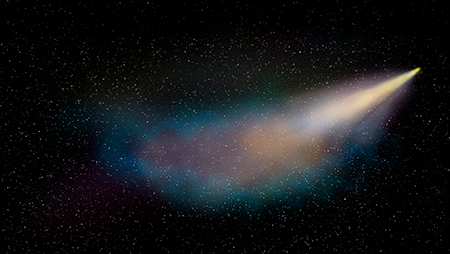SPACE
Space
Do you know your house number? What about the street on which you live? Do you know the name of it? What city or town do you call home? Most likely, you could give this information easily to someone who asked for it, along with much more (including the state and country in which you live). It is important to know where you reside. Just think, if you didn’t know where you lived, you couldn’t tell your friends how to get to your house or where they could mail you a letter.



We frequently talk to people about where we live. Friends, teachers, and many others often ask for our address. Because of how much time we spend at home and how much time we talk about it to others, the information is ingrained in our minds.
But how often do we talk about the bigger picture of where we live? We regularly chat about living on a particular street of one town in one state in the United States, but how much do we discuss the amazing fact that we live on the third planet from the Sun, which is located in the Milky Way Galaxy? Probably not enough.
The planet on which we live, called Earth, is located in what is known as a solar system. A solar system is made up of a group of celestial bodies (such as planets, moons, asteroids, and comets) that orbit a star. Our solar system includes a star (known as the Sun) and the eight planets that orbit it. Those eight planets are Mercury, Venus, Earth, Mars, Jupiter, Saturn, Uranus, and Neptune. Jupiter is the largest of all of the planets in our solar system, whereas Mercury is the smallest. [Astronomers (scientists who study planets, stars, and other things in space) used to say there were nine planets, with Pluto being the ninth, and smallest, and furthest from the Sun. The definition of the word “planet” changed, however, so that Pluto is no longer recognized as a planet.]


Earth is the fifth largest planet in our solar system and is located about 93 million miles from the Sun. It travels around the Sun—all 600 million miles—every year at approximately 70 Thousand miles per hour (or 19 miles per second). It has done this ever since God created the Sun on day four of Creation.
Earth follows the specific path that God made for it. As Earth moves through space around the Sun, it veers from a straight line about one-ninth of an inch every 18½ miles. If it veered by one-tenth of an inch every 18½ miles, the orbit would become so large that life on Earth would be impossible due to severely cold temperatures. If it veered by one-eighth of an inch every 18½ miles, life on Earth would be impossible due to its closeness to the Sun and drastically hot temperatures. Thankfully, Earth has always been (and remains) just the right distance from the Sun.




Whereas our solar system has one star in it (the Sun), according to astronomers, the galaxy in which we live, called the Milky Way Galaxy, contains more than 300 billion stars. The Milky Way Galaxy is so large that if you could pilot a spaceship that traveled the speed of light (186,000 miles per second), it would take you about 100,000 years just to get across it.
As large as the Milky Way Galaxy is, it is even more amazing to consider how our galaxy is only one of billions of galaxies in the Universe. (In fact, some think there are as many as two trillion galaxies.)
The Starry Sky
From our earthly perspective, stars appear very small in the night sky. We sometimes sing the popular nursery rhyme, “Twinkle, twinkle little star….” Actually, however, some of them (like the Sun) are about 1 million times larger than Earth. The largest known star is named UY Scuti, and hundreds of millions of Suns would fit inside its area. Stars only appear small in the nighttime sky because they are so far away.
In the long ago, astronomers used to think that stars numbered in the hundreds or thousands instead of the now-estimated billions and trillions. About 200 years before Jesus was born, the Greek astronomer Hipparchus stated that he believed there were from 800 to 1,080 stars in existence. About 300 years later, Ptolemy estimated there were about 1,050 stars. Even as recently as the 1600s, leading astronomers like Germany’s Johannes Kepler believed that there were only about 1,000 stars.
Interestingly, in speaking with Abraham about how numerous his descendants would be, God said: “Look now toward heaven, and count the stars if you are able to number them…. So shall your descendants be” (Genesis 15:5). Similarly, Jeremiah wrote: “The host of heaven cannot be numbered” (33:22). [Jeremiah was using intended exaggeration (a figure of speech) to mean that humans are simply incapable of counting every star God made.] The fact is, scientists have only relatively recently begun to learn what God stated in His Word thousands of years ago: stars are innumerable.
Scientists may estimate that there are many billion trillion stars in the Universe, but the fact is, they will never know for sure. The deeper into space we look, the more stars we find. How remarkable it is to think our God is so mighty and awesome that He was able to bring them all into existence on day four of Creation with simply the word of His mouth (Genesis 1:14-19). “Praise the name of the Lord, for He commanded and they were created” (Psalm 148:5).
Psalm 19:1-4
About 3,000 years ago, King David wrote:
“The heavens declare the glory of God; and the firmament shows His handiwork. Day unto day utters speech, and night unto night reveals knowledge. There is no speech nor language where their voice is not heard. Their line has gone out through all the earth, and their words to the end of the world.”

What God told us through His servant David is that we can look to the heavens, examine them from afar, and come to the right conclusion: there must be a Creator of something so big, beautiful, and well-designed. The heavens and the Earth testify day after day and night after night that “He who built all things is God” (Hebrews 3:4). “There is no speech nor language” of any mature person on Earth who cannot understand this truth. People may willfully choose not to believe it, but the evidence from the heavens for a Creator “has gone out through all the earth…to the end of the world.”
The amazing design of the “firmament (heavens) shows His [God’s] handiwork.” The countless number of stars in the night sky testifies to God’s greatness. The enormous size of the heavens declares His glory.
“For in six days the Lord made the heavens and the earth, the sea, and all that is in them….” Exodus 20:11
“The Lord is great and greatly to be praised” for “the Lord made the heavens.” Psalm 96:4,5

REPRODUCTION & DISCLAIMERS: We are happy to grant permission for this article to be reproduced in part or in its entirety, as long as our stipulations are observed.











0 Comments:
Post a Comment
<< Home